Abstract
Chromosomal DNA is considered a priori to be a target for the induction of numerical (whole chromosome) aneuploidy in mitotic cells. If true, DNA repair would be expected to contribute to genome stability. One type of repair that appears to play an important role in the response of many organisms to DNA-damaging agents involves recombination. Using the yeast Saccharomyces cerevisiae containing a pair of DNA divergent (homoeologous) chromosomes, we have been able to determine the importance of recombinational repair of DNA damage in the maintenance of chromosome number. Specifically, the induction of aneuploidy by ionizing radiation has been examined in diploids that had one chromosome III replaced by a divergent chromosome from Saccharomyces carlsbergensis. The chromosomes are functionally equivalent but lack precise DNA homology over one-half their length. The absence of homology, and thus the opportunity for recombinational repair (presumably of DNA double-strand breaks) in the divergent chromosomes, results in high levels (5-10%) of aneuploidy for chromosome III at doses of radiation resulting in almost no killing. For homologous chromosomes, the frequency of loss is 20-50 times lower.
Full text
PDF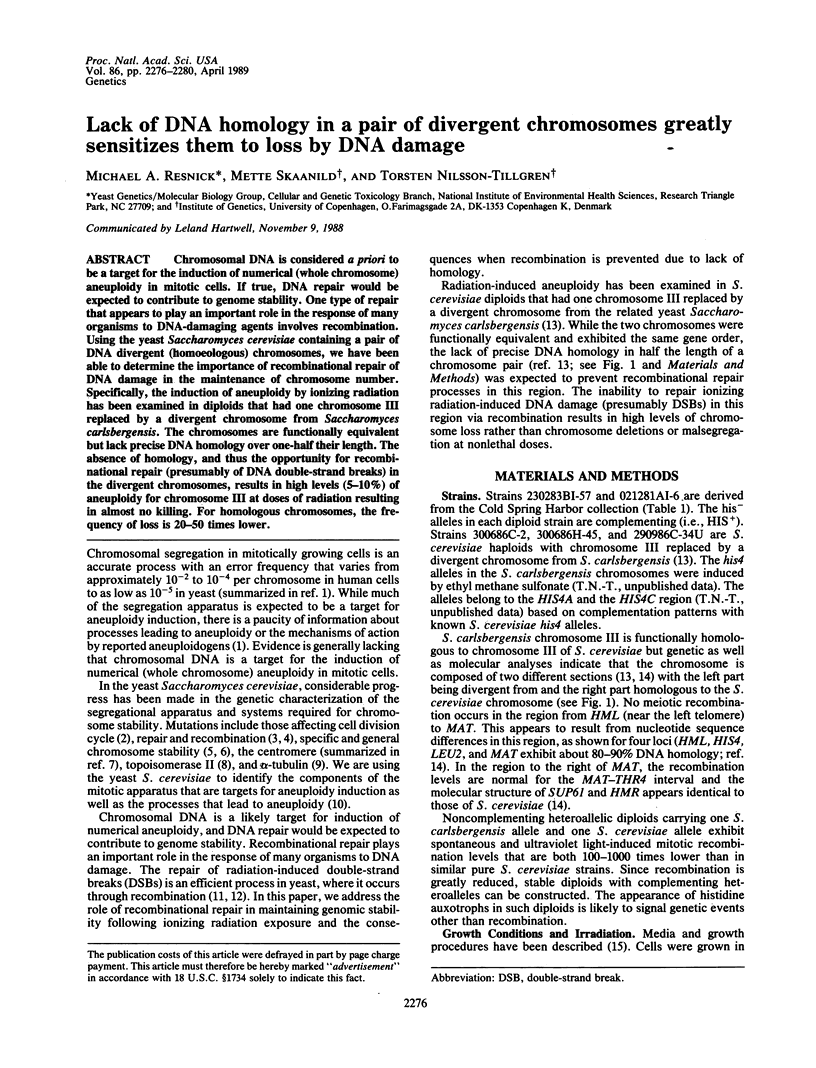
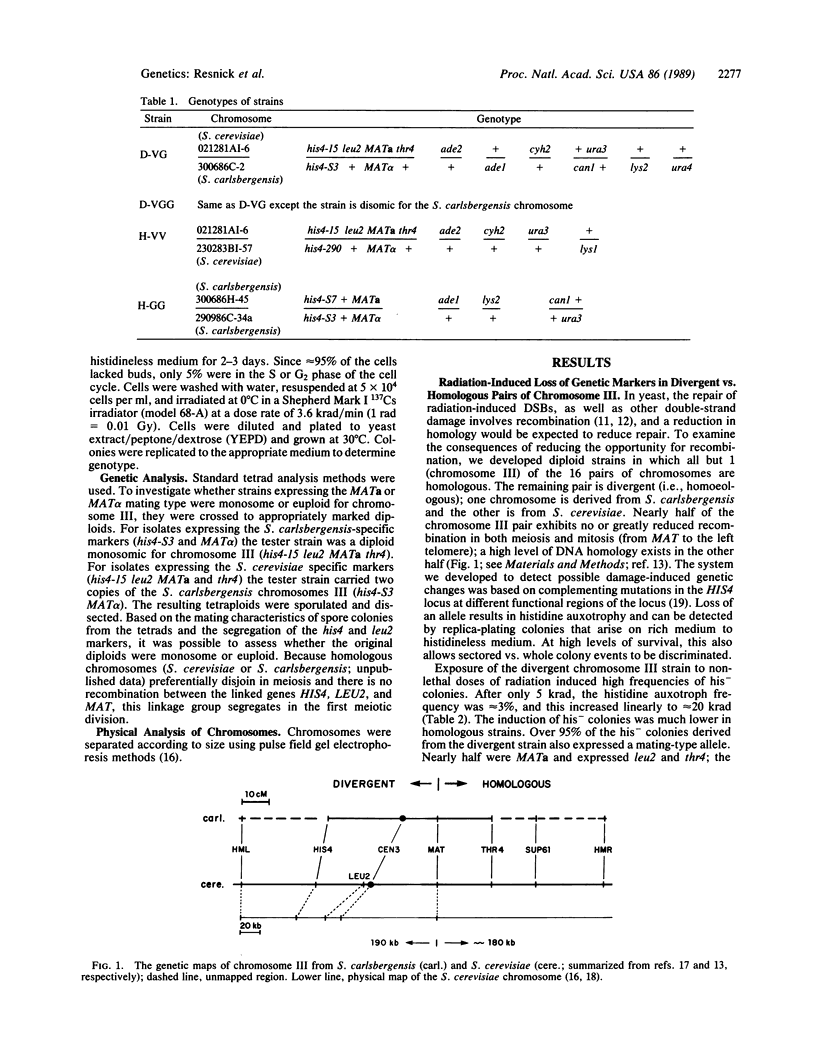
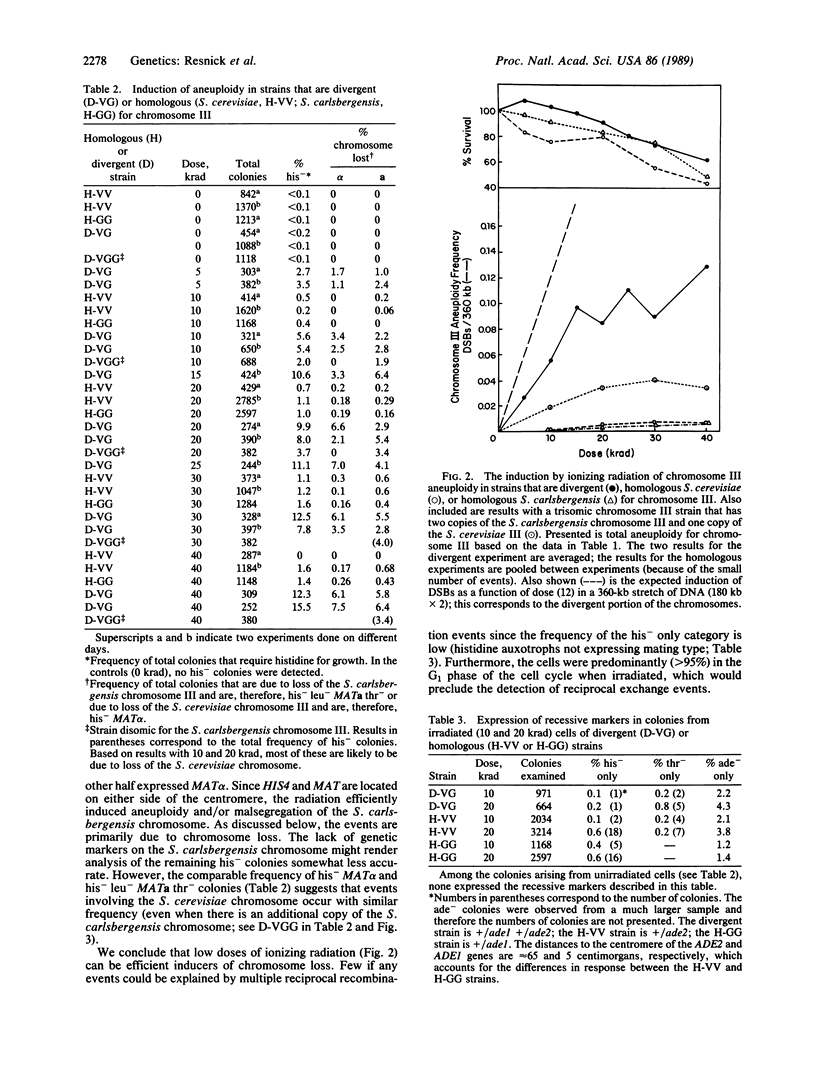
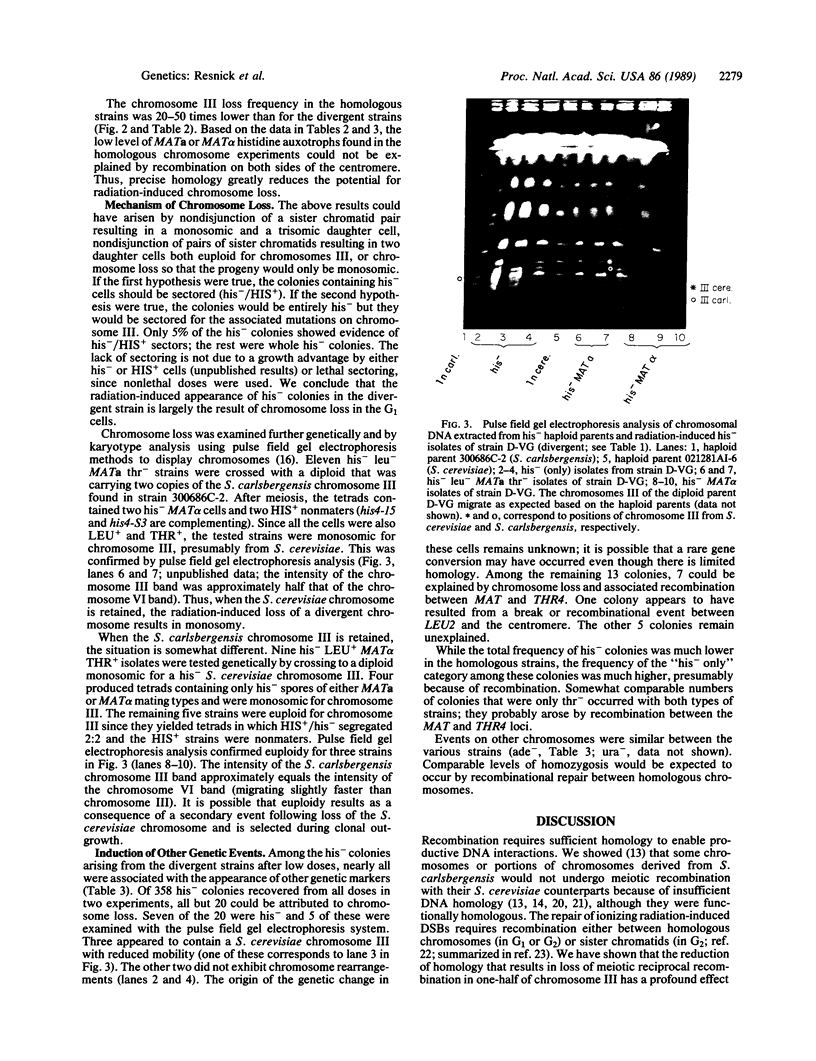
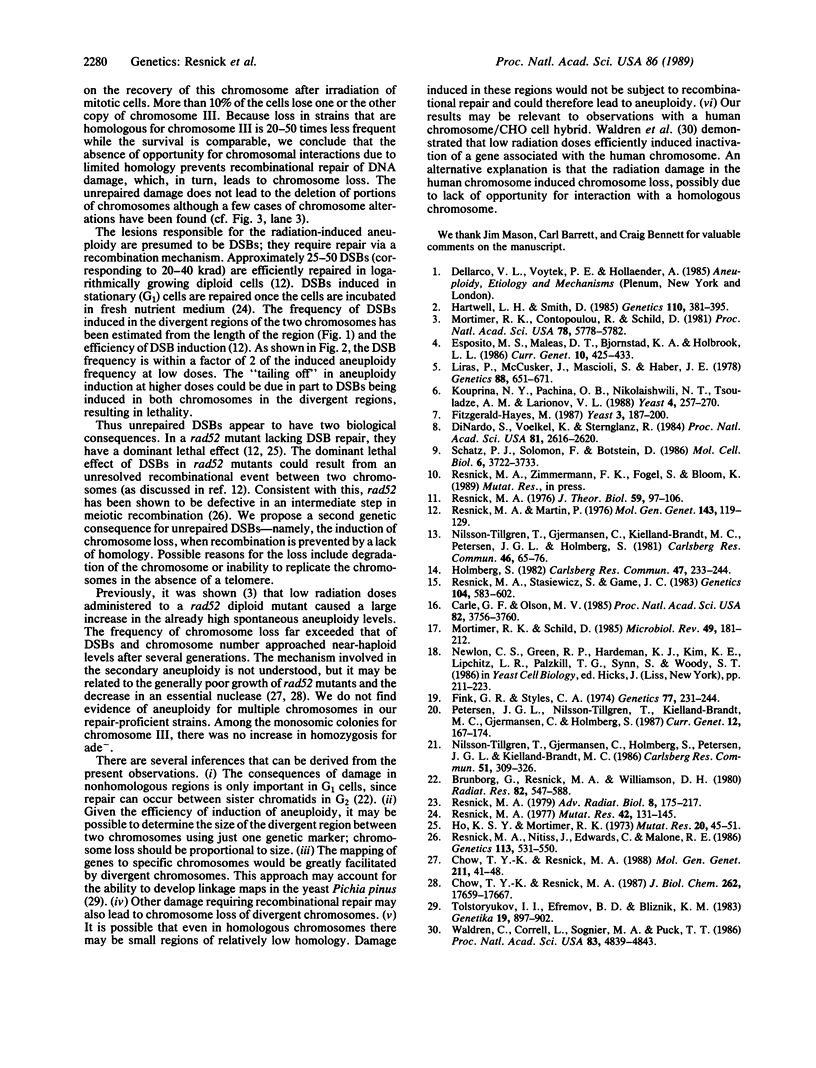
Images in this article
Selected References
These references are in PubMed. This may not be the complete list of references from this article.
- Brunborg G., Resnick M. A., Williamson D. H. Cell-cycle-specific repair of DNA double strand breaks in Saccharomyces cerevisiae. Radiat Res. 1980 Jun;82(3):547–558. [PubMed] [Google Scholar]
- Carle G. F., Olson M. V. An electrophoretic karyotype for yeast. Proc Natl Acad Sci U S A. 1985 Jun;82(11):3756–3760. doi: 10.1073/pnas.82.11.3756. [DOI] [PMC free article] [PubMed] [Google Scholar]
- Chow T. Y., Resnick M. A. An endo-exonuclease activity of yeast that requires a functional RAD52 gene. Mol Gen Genet. 1988 Jan;211(1):41–48. doi: 10.1007/BF00338391. [DOI] [PubMed] [Google Scholar]
- Chow T. Y., Resnick M. A. Purification and characterization of an endo-exonuclease from Saccharomyces cerevisiae that is influenced by the RAD52 gene. J Biol Chem. 1987 Dec 25;262(36):17659–17667. [PubMed] [Google Scholar]
- DiNardo S., Voelkel K., Sternglanz R. DNA topoisomerase II mutant of Saccharomyces cerevisiae: topoisomerase II is required for segregation of daughter molecules at the termination of DNA replication. Proc Natl Acad Sci U S A. 1984 May;81(9):2616–2620. doi: 10.1073/pnas.81.9.2616. [DOI] [PMC free article] [PubMed] [Google Scholar]
- Esposito M. S., Maleas D. T., Bjornstad K. A., Holbrook L. L. The REC46 gene of Saccharomyces cerevisiae controls mitotic chromosomal stability, recombination and sporulation: cell-type and life cycle stage-specific expression of the rec46-1 mutation. Curr Genet. 1986;10(6):425–433. doi: 10.1007/BF00419869. [DOI] [PubMed] [Google Scholar]
- Fink G. R., Styles C. A. Gene conversion of deletions in the his4 region of yeast. Genetics. 1974 Jun;77(2):231–244. doi: 10.1093/genetics/77.2.231. [DOI] [PMC free article] [PubMed] [Google Scholar]
- Fitzgerald-Hayes M. Yeast centromeres. Yeast. 1987 Sep;3(3):187–200. doi: 10.1002/yea.320030306. [DOI] [PubMed] [Google Scholar]
- Hartwell L. H., Smith D. Altered fidelity of mitotic chromosome transmission in cell cycle mutants of S. cerevisiae. Genetics. 1985 Jul;110(3):381–395. doi: 10.1093/genetics/110.3.381. [DOI] [PMC free article] [PubMed] [Google Scholar]
- Ho K. S., Mortimer R. K. Induction of dominant lethality by x-rays in radiosensitive strain of yeast. Mutat Res. 1973 Oct;20(1):45–51. doi: 10.1016/0027-5107(73)90096-1. [DOI] [PubMed] [Google Scholar]
- Kouprina NYu, Pashina O. B., Nikolaishwili N. T., Tsouladze A. M., Larionov V. L. Genetic control of chromosome stability in the yeast Saccharomyces cerevisiae. Yeast. 1988 Dec;4(4):257–269. doi: 10.1002/yea.320040404. [DOI] [PubMed] [Google Scholar]
- Liras P., McCusker J., Mascioli S., Haber J. E. Characterization of a mutation in yeast causing nonrandom chromosome loss during mitosis. Genetics. 1978 Apr;88(4 Pt 1):651–671. [PMC free article] [PubMed] [Google Scholar]
- Mortimer R. K., Contopoulou R., Schild D. Mitotic chromosome loss in a radiation-sensitive strain of the yeast Saccharomyces cerevisiae. Proc Natl Acad Sci U S A. 1981 Sep;78(9):5778–5782. doi: 10.1073/pnas.78.9.5778. [DOI] [PMC free article] [PubMed] [Google Scholar]
- Mortimer R. K., Schild D. Genetic map of Saccharomyces cerevisiae, edition 9. Microbiol Rev. 1985 Sep;49(3):181–213. doi: 10.1128/mr.49.3.181-213.1985. [DOI] [PMC free article] [PubMed] [Google Scholar]
- Resnick M. A., Martin P. The repair of double-strand breaks in the nuclear DNA of Saccharomyces cerevisiae and its genetic control. Mol Gen Genet. 1976 Jan 16;143(2):119–129. doi: 10.1007/BF00266917. [DOI] [PubMed] [Google Scholar]
- Resnick M. A., Nitiss J., Edwards C., Malone R. E. Meiosis can induce recombination in rad52 mutants of Saccharomyces cerevisiae. Genetics. 1986 Jul;113(3):531–550. doi: 10.1093/genetics/113.3.531. [DOI] [PMC free article] [PubMed] [Google Scholar]
- Resnick M. A., Stasiewicz S., Game J. C. Meiotic DNA metabolism in wild-type and excision-deficient yeast following UV exposure. Genetics. 1983 Aug;104(4):583–601. doi: 10.1093/genetics/104.4.583. [DOI] [PMC free article] [PubMed] [Google Scholar]
- Resnick M. A. The repair of double-strand breaks in DNA; a model involving recombination. J Theor Biol. 1976 Jun;59(1):97–106. doi: 10.1016/s0022-5193(76)80025-2. [DOI] [PubMed] [Google Scholar]
- Resnick M. A. Unrepaired double-strand breaks in nuclear DNA are not always lethal. Mutat Res. 1977 Jan;42(1):131–134. doi: 10.1016/s0027-5107(77)80016-x. [DOI] [PubMed] [Google Scholar]
- Schatz P. J., Solomon F., Botstein D. Genetically essential and nonessential alpha-tubulin genes specify functionally interchangeable proteins. Mol Cell Biol. 1986 Nov;6(11):3722–3733. doi: 10.1128/mcb.6.11.3722. [DOI] [PMC free article] [PubMed] [Google Scholar]
- Waldren C., Correll L., Sognier M. A., Puck T. T. Measurement of low levels of x-ray mutagenesis in relation to human disease. Proc Natl Acad Sci U S A. 1986 Jul;83(13):4839–4843. doi: 10.1073/pnas.83.13.4839. [DOI] [PMC free article] [PubMed] [Google Scholar]



